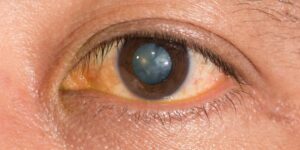A nuclear sclerotic cataract is a type of cataract that starts with a gradual hardening and yellowing of the lens’ central zone- also known as the nucleus. This type of cataract tends to develop slowly over time and can cause blurry vision and difficulty seeing colors. In this blog post, we will discuss the causes, treatment, and prevention of nuclear sclerotic cataracts. So keep reading on!
Contents
What Is Nuclear Sclerotic Cataract?
 A nuclear sclerotic cataract is a type of cataract that usually begins with a hardening of the nucleus, or central area, of the lens of the eye. This type of cataract is typically associated with aging and can cause blurry vision and glare sensitivity.
A nuclear sclerotic cataract is a type of cataract that usually begins with a hardening of the nucleus, or central area, of the lens of the eye. This type of cataract is typically associated with aging and can cause blurry vision and glare sensitivity.
Many people may be unaware that they have nuclear sclerotic cataracts until it is detected on an eye exam. It is estimated that this type of cataract affects up to one-quarter of those in their 60s and half of those over the age of 80. However, there are other causes that may lead to the development of nuclear sclerotic cataracts.
How Can You Identify It?
This might seem a bit obvious, but the first step to understanding nuclear sclerotic cataracts is knowing how to identify them. It appears as a progressive yellow or brown discoloration of the crystalline lens, which can be seen in a complete eye exam.
In addition, there are some common symptoms associated with nuclear sclerotic cataracts, such as:
- Blurred vision
- Glare or halos around lights
- Changes in color perception
- Difficulty with night vision
- Double vision
- Light sensitivity
If you experience any of these symptoms it is important to visit a doctor for an exam to rule out other diseases and diagnose the condition.
What Causes Nuclear Sclerotic Cataracts?
It is often believed that nuclear sclerotic cataracts are caused by the normal wear and tear associated with aging, but there are other factors that can increase a person’s risk of developing this condition. These include:
UV exposure
This type of cataract is often linked to sun exposure, as excessive UV light can damage the proteins in the lens and cause them to clump together. For example, people who spend a lot of time outdoors without adequate eye protection are more likely to develop this type of cataract later in life.
Smoking
Studies have found that smoking can increase a person’s risk of developing this type of cataract. As it affects the proteins in the lens, it can lead to them clumping together and forming a cataract.
Diabetes
People with diabetes are more likely to develop cataracts, including nuclear sclerotic cataracts. This is because diabetes can cause changes in the proteins of the lens, leading to the formation of a cataract.
Previous eye surgery or trauma
Trauma or surgery to the eye can also lead to nuclear sclerotic cataracts. This is because changes in the proteins of the lens can occur when there has been damage to it. For instance, if you have had previous eye surgery, you may be more likely to develop this type of cataract later in life.
Certain medications
Finally, certain medications can also increase your risk of developing this type of cataract. For example, long-term use of corticosteroid medications may affect the proteins in the lens, leading to a nuclear sclerotic cataract.
All in all, these are the most common causes of nuclear sclerotic cataracts. If you’re concerned about your risk, it’s important to talk to your doctor about any potential risk factors and ways to reduce them.
How Can You Treat It?
 When it comes to treating nuclear sclerotic cataracts, the first option is usually to have surgery. The most common form of cataract surgery involves removing the cloudy lens and replacing it with a clear one. The new lens can be tailored to your specific vision needs, such as nearsightedness, farsightedness, or astigmatism.
When it comes to treating nuclear sclerotic cataracts, the first option is usually to have surgery. The most common form of cataract surgery involves removing the cloudy lens and replacing it with a clear one. The new lens can be tailored to your specific vision needs, such as nearsightedness, farsightedness, or astigmatism.
In some cases, surgery may not be necessary and medications or other treatments may be recommended. For example, wearing glasses or contact lenses with anti-reflective coating can help to reduce symptoms and improve vision.
The treatment generally depends on the severity of the cataract and the patient’s individual needs. Before deciding which treatment is best, it’s important to discuss all your options with a doctor or eye care professional.
With the right treatment, it’s possible to regain clear vision and reduce the risk of further damage.
How Can You Prevent Nuclear Sclerotic Cataracts?
Although nuclear sclerotic cataracts can’t be completely prevented, there are some steps you can take to reduce your risk. These include:
- Wearing sunglasses when outdoors: UV exposure is a major risk factor for cataracts, so make sure you protect your eyes with 100% UV-blocking sunglasses.
- Eating a healthy diet: Eating foods rich in antioxidants like fruits and vegetables can help maintain healthy vision.
- Getting regular eye exams: Regular checkups can help detect any changes in your vision that could be the first sign of a developing cataract.
- Quit smoking: It is well known that smoking can increase the risk of cataracts, so quit smoking to give your eyes a fighting chance.
- Avoid eye strain and fatigue: Staring at a computer screen or television for extended periods of time can put a strain on your eyes, so be sure to take breaks and look away frequently.
These things are not only important for preventing cataracts, but they are also essential for maintaining good overall eye health. By taking care of your eyes and making the necessary lifestyle changes, you can reduce your risk of developing nuclear sclerotic cataracts.
Do not hesitate or delay seeing an eye doctor if you experience any changes or problems with your vision. Early detection and treatment can help prevent the progression of nuclear sclerotic cataracts and protect your long-term vision health.
Conclusion
To conclude, nuclear sclerotic cataract is seemly increasingly common, especially with age. Understanding the causes, treatments, and preventative measures can help in better managing this condition. It is important for people to understand that symptoms may not be obvious at first. But can progress over time if left untreated.
As such, regular eye exams are recommended as a way to monitor any changes or potential development of nuclear sclerotic cataracts. Early detection is key to the successful treatment and prevention of this condition!
Cataract surgery is a safe and painless procedure. At MantraCare we have a team of experienced eye surgeons, who will be happy to answer any questions on cataract surgery. Call us at +91-9711116605 for any inquiries.
